Hawks typically build their nests in the tallest, most mature trees in cemeteries, usually 60-80 feet above ground. You’ll find these large stick platforms positioned where branches meet the trunk, offering stability and unobstructed views. Red-tailed and Cooper’s Hawks prefer trees at cemetery edges where woodlots meet open spaces, giving them excellent hunting visibility. Look for trees that stand apart from others or along the perimeter for your best chance at spotting these remarkable aerial architects.
Why Red-tailed Hawks Choose Cemetery Trees
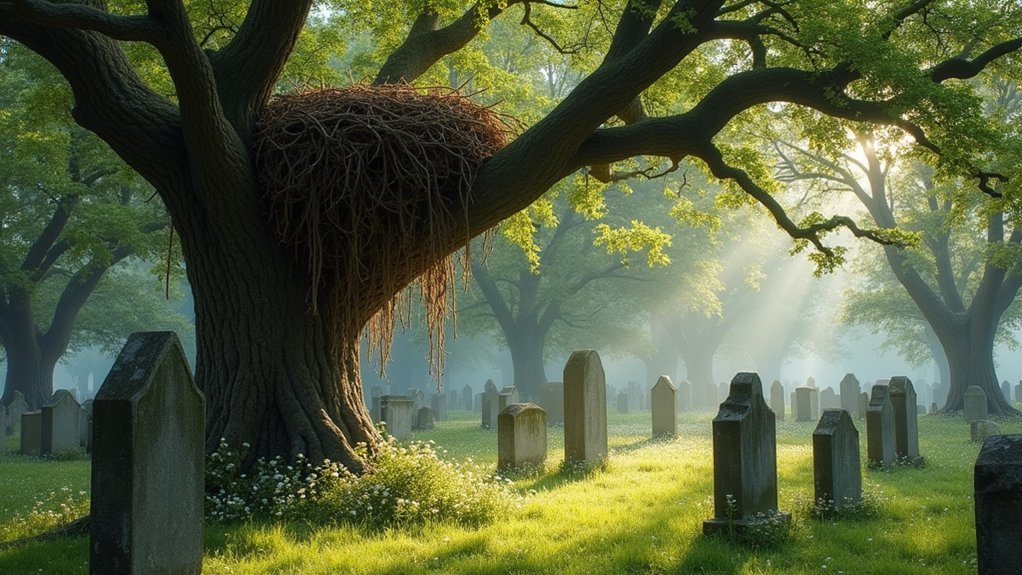
While many birds seek shelter in forests or parks, Red-tailed Hawks demonstrate a particular affinity for cemetery trees when establishing their nests.
You’ll notice these raptors strategically select the tallest, most mature trees that offer commanding views of the surrounding landscape. This vantage point is essential for spotting both prey and potential threats.
Cemetery environments provide ideal conditions for Red-tailed Hawk nests due to their relative tranquility.
With less human disturbance than typical urban settings, hawks can raise their young with minimal interference. The adjacent open fields commonly found along cemetery borders serve as perfect hunting grounds for small mammals and birds.
These hawks value stability, often returning to the same cemetery trees year after year if previous breeding attempts proved successful, demonstrating remarkable site fidelity.
Identifying Ideal Nesting Locations Among Gravestones
When observing hawk nesting behavior in cemeteries, you’ll find these birds aren’t selecting locations randomly. They’re strategic, preferring the tallest trees that provide commanding views of the surrounding landscape and potential prey.
Look for nests along cemetery edges where woodlots meet open spaces—these transitional zones create perfect hunting grounds. Hawks value sturdy, high branches that can support their substantial nests while keeping them safe from ground predators.
You’ll notice these raptors often return to the same trees year after year, particularly in cemeteries where human activity remains minimal and predictable.
This loyalty to specific sites makes cemeteries excellent locations for springtime observation, when you can witness their fascinating courtship displays and nest-building activities before eggs are laid.
Seasonal Timeline of Cemetery Hawk Nesting
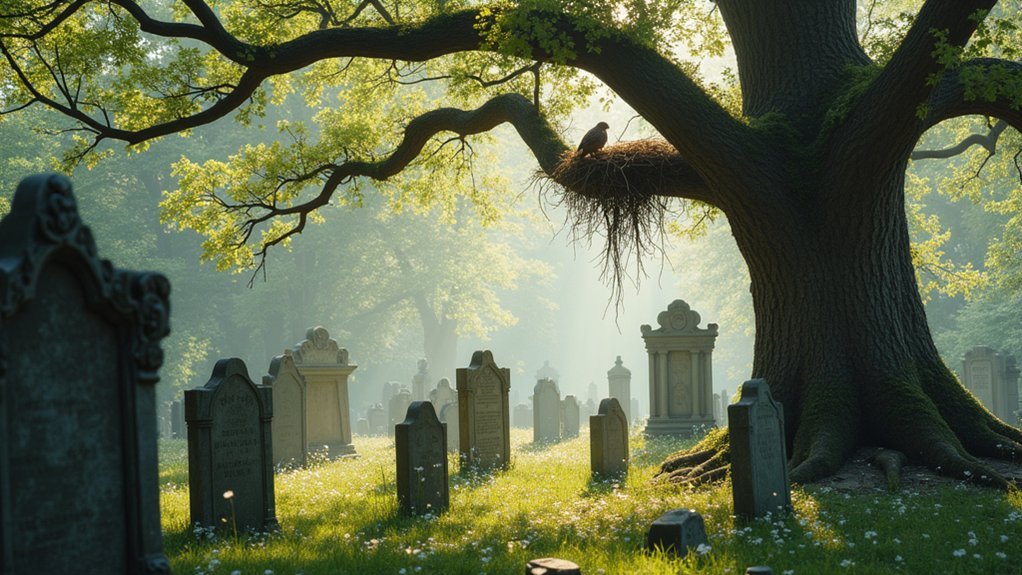
The seasonal rhythm of hawk nesting in cemetery environments follows a predictable pattern you can mark on your calendar. When Canadian geese return and early spring warmth arrives, red-tailed hawks begin their nesting activities in the tall trees along cemetery edges.
| Season | Hawk Nesting Activity |
|---|---|
| Early Spring | Nest construction (4-7 days) in tall cemetery trees |
| Mid-Spring | Egg-laying (2-4 eggs) with 2-3 days between each |
| Late Spring | Incubation period (28-35 days) shared by both parents |
| Early Summer | Nestlings fledge (42-46 days after hatching) |
Mated pairs, typically monogamous, often return to the same nesting sites year after year—some cemetery hawks have used the same territories since 2012. After fledging, young hawks remain nearby for up to six weeks, learning hunting skills from their parents.
How to Spot Active Hawk Nests in Mature Trees
You’ll find hawk nests by looking for large stick platforms nestled in the upper branches of mature trees with sturdy limbs and open canopies.
Watch for telltale signs of activity including whitewash beneath the trees, circling adults, and agitated behavior from smaller birds in the vicinity.
Your search will be most successful during breeding season from late winter through early summer when hawks are actively maintaining their nests and raising young.
Nest Identification Signs
Spotting an active hawk nest requires careful observation and knowledge of key identification signs. When examining mature cemetery trees, look for large, bulky structures made of sticks and twigs positioned 20-50 feet above ground.
You’ll notice hawks regularly returning to these nests or perching nearby during breeding season.
Evidence of nesting activity includes:
- Scattered feathers and prey remains at the tree’s base
- Fresh sticks and leaves being added to the nest structure
- Distinctive hawk calls becoming more frequent and territorial
Listen carefully for these vocalizations, especially in spring when breeding pairs become more vocal.
Over time, you’ll observe parents bringing food to the nest with increasing frequency—a clear sign that eggs have hatched.
Protective behaviors, including aggressive swooping at potential threats, also indicate an active nesting site.
Distinctive Tree Characteristics
Mature trees with certain distinctive features consistently attract nesting hawks year after year.
You’ll notice hawks prefer trees with strong, sturdy central trunks that can support their substantial nests, which often measure several feet in diameter.
Look for tall specimens that stand apart from surrounding vegetation, providing hawks with unobstructed views of hunting grounds.
The most appealing tree characteristics include robust lateral branches high in the canopy, especially those situated at the forest edge or overlooking open fields.
Hawks select these locations for maximum visibility while maintaining protection from predators.
Trees that offer stability during high winds are particularly desirable.
When scanning potential nesting sites, focus on trees with accessible flight paths and minimal obstructions, as hawks need clear approaches to their nests while carrying prey or nesting materials.
Seasonal Timing Matters
When early spring arrives, hawk nesting activity intensifies, creating the perfect window for observing these magnificent birds establish their homes.
Red-tailed hawks typically begin their nesting process as temperatures warm and songbirds return. You’ll find most active nests between mid-March and late April, when the 28-35 day incubation period begins.
Look for these telltale signs of an active nesting site:
- Mated pairs performing dramatic aerial courtship displays above cemetery trees
- Hawks carrying sticks and nesting materials to the same tall tree repeatedly
- Increased territorial behavior, including calling and defending a particular area
Since red-tailed hawks often reuse successful nesting sites year after year, return to previously documented locations to increase your chances of spotting these remarkable raptors during breeding season.
The Relationship Between Cemetery Landscaping and Hawk Habitat
The impressive height of cemetery trees has unintentionally created perfect hawk habitats across many burial grounds. You’ll often see Red-tailed hawks perched on these tall sentinels, scanning for prey before swooping down to catch their next meal.
These raptors carefully select these locations for raising their young, with a typical Hawk pair returning year after year if they’ve successfully raised a clutch of eggs.
Cemetery landscapes offer the ideal environment for the breeding cycle, with minimal human disturbance allowing hawk chicks to develop naturally. The combination of wooded edges and open spaces creates a buffet of small mammals and birds for hungry young hawks.
After their first flights, these young birds often remain nearby for weeks after fledging, perfecting their hunting skills before they leave the nest completely.
Observing Hawk Courtship Displays in Cemetery Settings
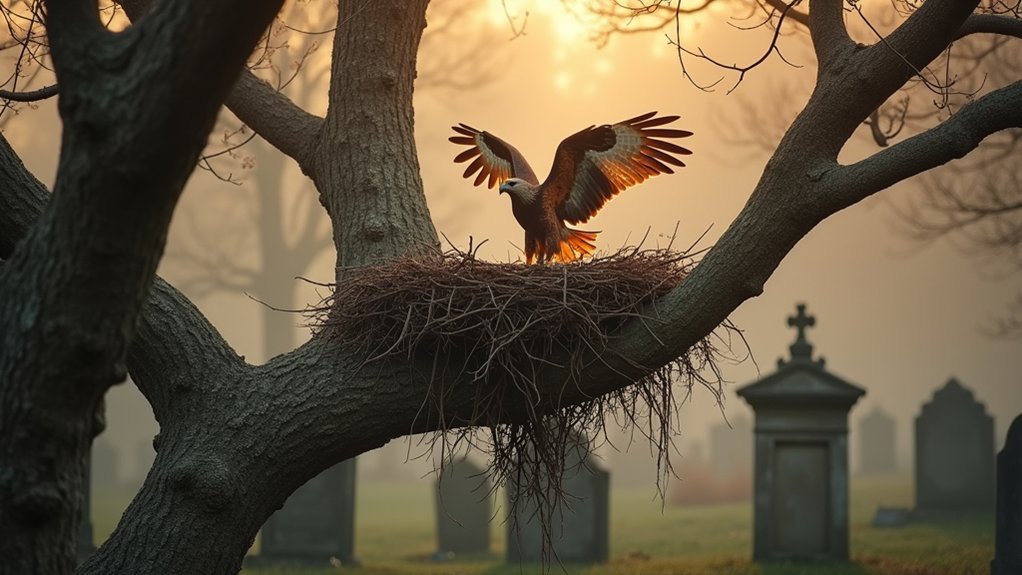
You’ll witness red-tailed hawks performing spectacular aerial courtship maneuvers above cemetery trees, including soaring loops and dramatic plunges that showcase their strength to potential mates.
The tall monuments and mature trees serve as perfect territorial display locations where hawks call loudly and demonstrate their flying prowess without much human interference.
During late winter and early spring, watch carefully for mate selection behaviors such as mutual preening, food sharing between pairs, and the collaborative gathering of nesting materials—all signals that these majestic birds have chosen your local cemetery as their breeding grounds.
Aerial Courtship Maneuvers
Spring visitors to cemetery grounds may witness one of nature’s most enchanting aerial displays as red-tailed hawks perform their elaborate courtship rituals.
As the weather warms, watch for male hawks soaring high above the cemetery’s tall trees, showcasing their flying prowess to attract potential mates.
These courtship displays aren’t just beautiful—they’re essential for establishing lifelong pair bonds.
You’ll notice mated pairs often return to the same nesting sites year after year, reinforcing their connection through these annual performances.
- Males diving dramatically from great heights, then pulling up with impressive precision
- Pairs circling together in synchronized flight patterns against the blue spring sky
- Hawks calling to each other with distinctive cries that echo across the peaceful cemetery grounds
Territorial Display Locations
While many birdwatchers travel to remote natural areas, cemetery grounds offer surprisingly ideal vantage points for observing hawk territorial displays. You’ll find Red-tailed and Cooper’s Hawks performing their courtship rituals in the open spaces surrounding cemetery trees, particularly during early spring.
These locations aren’t chosen randomly. The elevated trees provide hawks with exceptional visibility, while the surrounding open fields create perfect theaters for their aerial performances.
As you watch, you’ll see impressive acrobatic flight patterns where the birds soar high before diving dramatically to demonstrate strength to potential mates.
If you’re hoping to witness these territorial displays, position yourself near mature cemetery trees with clear sightlines. The increased birdwatching interest in these areas confirms their importance as crucial raptor habitats worth protecting.
Mate Selection Behaviors
Beyond territorial displays, hawk courtship rituals reveal fascinating mate selection dynamics that cemetery visitors can observe firsthand.
If you’re patient in early spring, you’ll witness red-tailed hawks engage in elaborate aerial performances as they evaluate potential partners. These displays aren’t merely for show—they’re critical assessments of strength, hunting prowess, and compatibility.
- Males soaring high above cemetery trees before diving dramatically, their red tails flashing in the sunlight as females watch from perches
- Pairs flying in synchronized patterns between marble monuments and ancient oaks, their wingtips nearly touching as they build their connection
- A male hawk presenting freshly caught prey to his potential mate, demonstrating his hunting abilities as she evaluates his offering from a nearby branch
Cemetery settings offer perfect vantage points for observing these intimate rituals unfold.
Nest Construction Materials and Techniques
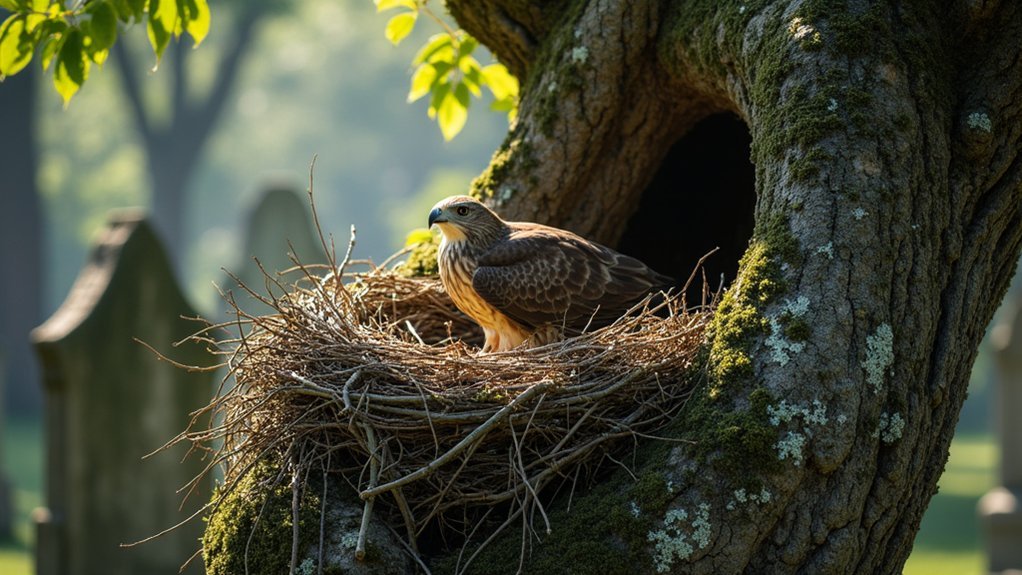
When red-tailed hawks begin the intricate process of nest building, they rely primarily on sticks, twigs, and bark to create sturdy platforms that will support their families. Both partners participate in this shared labor, typically completing their nest within 4-7 days.
You’ll find these nests perched high in cemetery trees, often 60-80 feet above ground, where the hawks gain perfect vantage points to survey open fields for prey while staying safe from ground predators. They purposefully select sturdy tree species that can withstand their substantial structures.
What’s fascinating is how these hawks often return to the same nest year after year. They’ll reinforce their previous construction with fresh materials each season, gradually developing impressive architectural works that grow more complex and substantial over time.
Cemetery Hunting Grounds: Prey Availability for Nesting Hawks
As hawks establish their nests in cemetery trees, they’re strategically positioning themselves above perfect hunting grounds. The diverse habitat of cemetery landscapes offers a buffet of prey options with minimal human interference.
You’ll notice Red-tailed and Cooper’s hawks taking advantage of tall perches to scan open areas while maintaining proximity to wooded edges where small mammals scurry.
- Sunlight filtering through ancient oaks as a Cooper’s hawk swoops down on an unsuspecting songbird feeding near a weathered headstone
- A red-tailed hawk gliding silently between memorial statues before pouncing on field mice darting across freshly mown grass
- Fledgling hawks practicing hunting skills at dusk when cemetery visitors have departed and rabbits emerge from thicket edges
Spring brings increased hunting success as migratory birds return and rodent populations become more active.
Weather Impacts on Cemetery Hawk Nests
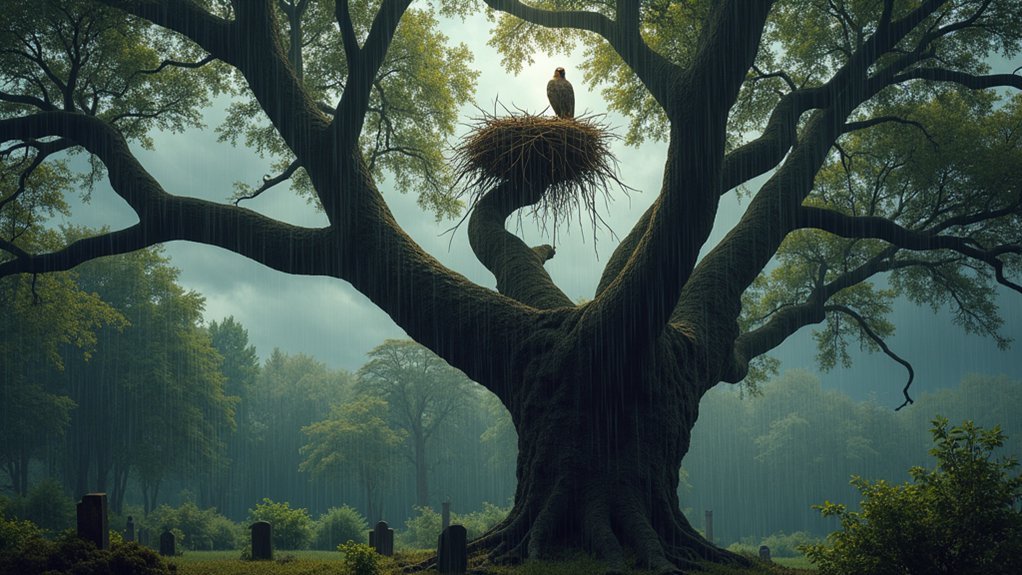
You’ll notice that cemetery hawk nests face significant challenges during severe storms, with strong winds threatening their structural integrity and potentially dislodging eggs or nestlings.
The temperature around these nests directly influences hatching timelines, sometimes extending the typical 28-35 day incubation period during unseasonably cool weather.
Heavy precipitation forces hawks to adapt their nest construction techniques, often incorporating additional materials to reinforce against moisture or seeking more sheltered locations within the cemetery’s tallest trees.
Severe Storm Nest Stability
Despite their careful construction, hawk nests in cemetery trees face significant challenges during severe weather events.
You’ll notice that red-tailed hawks invest considerable effort in selecting sturdy branches to withstand high winds, but even the most robust nests remain vulnerable. During the critical 28-35 day incubation period, storm damage can be particularly devastating to reproductive success.
- Twisted branches swaying violently as driving rain pelts the carefully woven sticks of a hawk’s nest
- Parent hawks hunched protectively over eggs while their nest platform shifts precariously in gusting winds
- Fresh twigs and branches hurriedly gathered and woven into existing nest structures ahead of darkening storm clouds
Observant cemetery visitors might spot hawks reinforcing their nests before storms arrive—an adaptive behavior that increases nest stability and ultimately improves fledgling survival rates.
Temperature’s Hatching Influence
Temperature fluctuations throughout the nesting season powerfully influence hawk egg development and hatching success in cemetery habitats.
You’ll notice that hawks require precise thermal conditions of 35-37°C (95-98.6°F) for ideal incubation, with deviations potentially extending the typical 28-35 day incubation period to as long as 41 days, as documented in Cornell University hawks.
When you observe hawks arriving earlier to cemetery trees during warmer springs, you’re witnessing temperature’s direct impact on nesting behaviors and egg-laying timing.
Warmer conditions can accelerate embryonic development, leading to earlier hatches in favorable seasons.
Be aware that extreme weather events pose significant risks to nestlings.
Unseasonably cold temperatures or heavy downpours disrupt food availability and compromise parental care, directly affecting survival rates of young hawks in cemetery nest sites.
Precipitation Affecting Nest Construction
Precipitation patterns considerably shape how hawks approach nest construction throughout cemetery landscapes.
You’ll notice hawks adapt their building strategies during wet periods, often selecting sites with natural overhead protection from dense foliage.
When cemetery grounds become saturated after heavy rains, hawks face significant challenges gathering suitable nesting materials and maintaining structural integrity of existing nests.
- Raindrops cascading through oak branches while a red-tailed hawk struggles to break off a soaked twig
- A hawk pair hastily reinforcing their partially built nest before an approaching storm front reaches the cemetery’s eastern section
- Morning fog lifting to reveal a hawk’s strategic nest placement in the uppermost crook of a pine tree, safely above potential flood zones
Ethical Guidelines for Cemetery Hawk Watching
When observing hawks in cemetery settings, you’ll need to balance your enthusiasm for wildlife with respect for these sacred spaces.
Always maintain a respectful distance from nesting hawks, as approaching too closely may cause adults to abandon their nests.
Bring binoculars or a zoom lens camera to observe the birds without intruding on their territory.
Before visiting, research local regulations and nesting seasons, as many cemeteries have specific guidelines protecting wildlife.
Document your observations quietly and discreetly, minimizing any disruption to both the hawks and mourners.
Share your findings with birding communities and conservation groups to contribute valuable data.
Remember not to feed hawks or attempt to habituate them to human presence.
This maintains their natural foraging behaviors and survival instincts—critical for their long-term welfare.
Comparing Urban vs. Rural Cemetery Nesting Success
Hawks nesting in cemeteries face distinctly different challenges and advantages depending on whether they’ve chosen urban or rural locations.
Red-tailed Hawks frequently select urban cemetery trees for their height and visibility, while Cooper’s Hawks prefer the denser foliage of rural settings.
You’ll notice urban nests often achieve higher success rates due to reduced human interference during essential nesting periods.
- Red-tailed Hawks perched atop ancient oaks overlooking marble headstones, scanning for movement among the graves below
- Cooper’s Hawks nestled within thick evergreens at rural cemetery edges, their nests hidden from casual observers
- Fledglings testing their wings between tombstones as parent hawks deliver fresh prey captured from the cemetery grounds
Food availability plays a critical role—urban settings provide abundant small mammals, while rural success varies due to habitat fragmentation and competition with other raptors.
Cemetery Management Practices That Support Raptor Conservation
Thoughtful cemetery management creates essential sanctuaries for raptors amid increasingly developed landscapes. You’ll find hawks thrive in cemeteries that maintain diverse tree canopies, which provide ideal nesting sites while ensuring prey availability.
| Practice | Benefit | Implementation |
|---|---|---|
| Diverse tree canopy | Nesting sites for hawks | Plant mixed species of varying ages |
| Organic pest control | Healthier ecosystem | Avoid chemicals that harm prey species |
| Snag preservation | Hunting perches | Leave dead trees standing when safe |
| Community education | Conservation support | Host birding events and workshops |
| Population monitoring | Informed management | Partner with wildlife organizations |
Documenting Cemetery Hawks: Photography Tips and Strategies
Capturing stunning images of hawks in cemetery settings requires both technical skill and respect for these magnificent raptors. Equip yourself with a telephoto lens to photograph hawks without disturbing their natural behavior or nesting sites.
Schedule your photography sessions during early morning or late afternoon when the golden light enhances feather details and creates atmospheric cemetery scenes.
The golden glow of dawn and dusk bathes hawks in ethereal light, perfect for capturing their majestic presence among timeworn monuments.
- A red-tailed hawk silhouetted against dawn light, perched atop a century-old oak tree overlooking weathered gravestones
- Hawk parents carefully arranging twigs in their nest, framed by the ornate stonework of a mausoleum in the distance
- A juvenile hawk’s first flight captured in motion, wings spread against the backdrop of cemetery cypress trees
Remember to remain patient and quiet, allowing the hawks to become comfortable with your presence before attempting close-up shots.
Frequently Asked Questions
What Kind of Trees Do Hawks Nest In?
You’ll find hawks nesting in tall oaks, pines, and cottonwoods that provide good visibility. They prefer trees reaching 30-80 feet high, especially those situated at forest edges near open hunting grounds.
Where Do Hawks Build Their Nests?
Hawks build their nests in tall trees, particularly at woodland edges. You’ll find them constructing homes with sticks and twigs high above the ground, often reusing sites that offer good hunting views and minimal disturbance.
How Do You Identify a Hawk’s Nest?
You’ll identify a hawk’s nest by its large platform structure (up to three feet wide) with a shallow center cup, located high in trees. Look for sticks, twigs, feathers, prey remains, and protective adult hawks nearby.
What Time of Year Do Hawk Eggs Hatch?
You’ll see hawk eggs hatching in late spring, typically 28-35 days after they’re laid. The female and male share incubation duties, with nestlings remaining in the nest for 42-46 days before fledging.
In Summary
You’ve discovered something special in cemetery trees – a hidden world where hawks find sanctuary among the memorials. By respecting their space and following ethical viewing practices, you’ll witness nature’s resilience in these peaceful settings. Whether urban or rural, these cemetery hawks remind us that life continues its cycles in unexpected places. Your observations might even contribute to conservation efforts that protect these magnificent birds for generations to come.





Leave a Reply